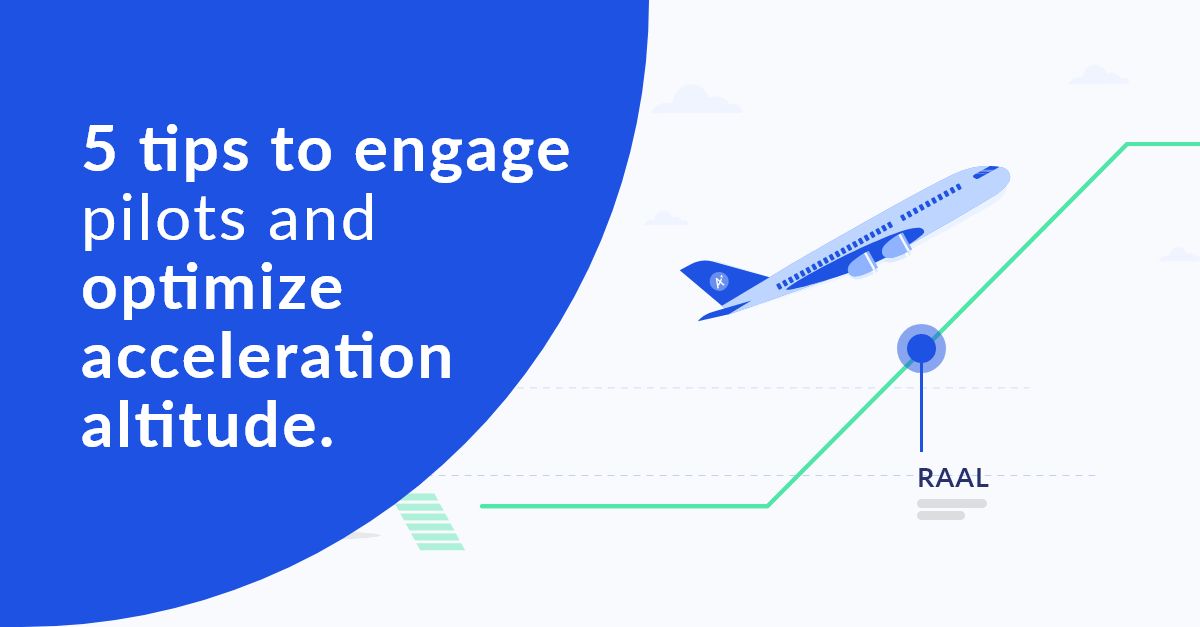5 tips for engaging pilots in applying Reduced Acceleration Altitude
Reduced Acceleration Altitude (RAAL) is one of the most common best practices in terms of fuel-saving actions to execute by pilots. But how to apply it and increase the application rate? Creating a new habit can be a challenge! In this short article, we will guide you through a few tips that can help you better engage your pilots and improve your airline’s RAAL performance.
Read this article to know more about Reduced Acceleration Altitude: What you need to know about Reduced Acceleration Altitude.
|
Summary |
1. Pay attention to the feasibility of Reduced Acceleration Altitude during the pre-flight briefing
Airports often have defined Noise Abatement Departure Procedures (NADP) that prevent accelerating early. In the absence of a specific Noise Abatement procedure, it should ring a bell in your pilots’ mind: it means that RAAL is applicable!
Typically, your pilots get the NADP information in navigation charts during the flight preparation. Still, anything that your flight ops department can do to make the information easier to find will increase effectiveness. You can consider preparing a list of airports where RAAL is/is not applicable and share it with pilots in their briefing package. It will give them clear ideas on when and where it is possible to apply the fuel-saving procedure.
 |
Learn more about eco-flying >> |
2. Use data to convince pilots
Monitoring and improvement are linked. Your pilots may have doubts about the feasibility of accelerating earlier because they are not used to it. Comments like “I’m too busy to consider this during takeoff and climb” may come in once you start rolling out the new procedure. They may also consider it’s not safe to do so. With a set of historical data, you can demonstrate the achieved application rate at each airport. Once pilots are aware of the actual situation, they might start to think about their flights with similar conditions and apply it!
3. Set up a company Standard Operating Procedures (SOP) for acceleration altitude
Clear instructions written in the SOP is the best way to engage your pilots. This will make sure the fuel-saving initiative has been cautiously evaluated by the flight ops engineers and is acknowledged by all the pilots. On most modern aircraft, the manufacturers allow acceleration altitude to be reduced from 3000 ft to 800 ft when there is no specified NADP1 procedure. It is possible to go down to 400 ft for lighter aircraft.
4. Introduce RAAL in pilot training
It is always a good idea to train your pilots with a fuel-saving mindset since day one. By incorporating the reduced acceleration altitude to your pilot training, you can ensure this concept is kept in their mind, and they can apply it as naturally as other procedures. Besides, you can clearly explain what your expectation is and how to apply it during the training practically. When you introduce something new compared to what they are used to, it is essential to show them how to do it.
Related content >>> E-learning course on fuel efficiency!
5. Implement a tool to let pilots self-evaluate
You cannot encourage pilots to apply Reduced Acceleration Altitude but not give them anything to review their performance. A self-evaluation tool can make pilots aware of their performance. If they can visualize their progress, it will probably give them even more motivation to continue applying RAAL! Once they know what they are doing and where the target is, they will try to catch up on the goal.
Want to boost your RAAL performance? Try one or many of these tips ;)
Grow fuel culture among your pilots
The OpenAirlines Academy: A resource center for pilots to strengthen their understanding of fuel efficiency principles.




